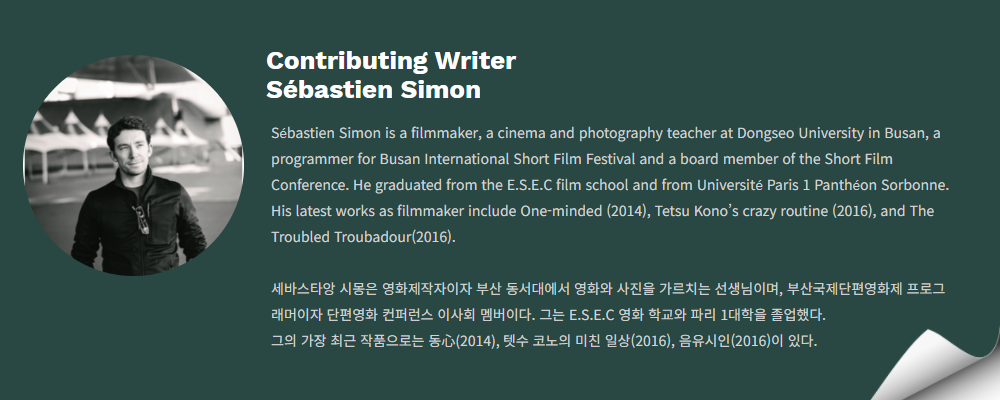The Beat : a Window to Busan’s Past
더 비트(The Beat) : 부산의 과거를 향한 창
The Beat : a Window to Busan’s Past
더 비트(The Beat) : 부산의 과거를 향한 창
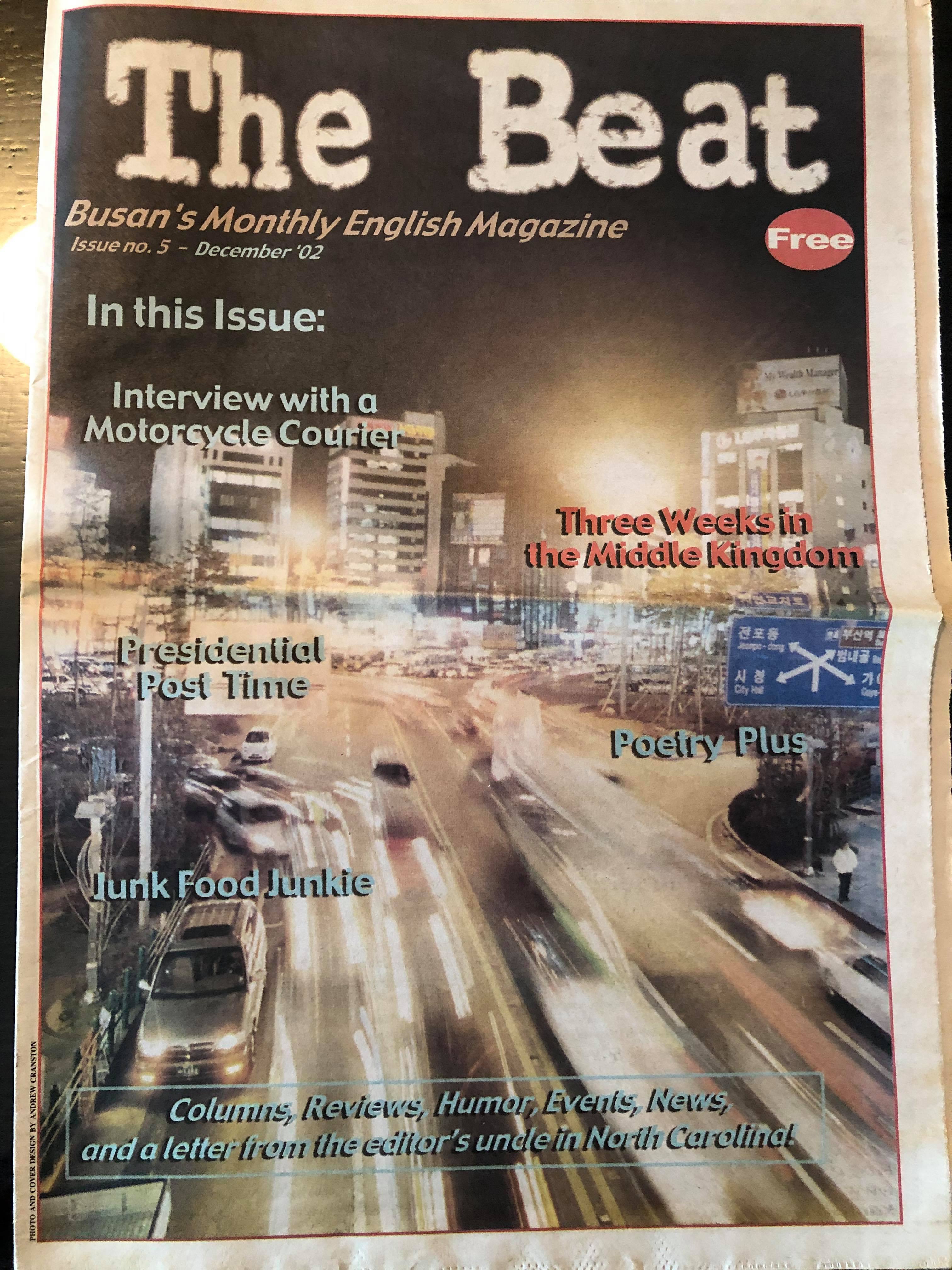
Imagine that it’s August 2002: you are arriving at Busan Station and, as you drop by its Information Center, you see a newspaper boasting this curious headline: Slain by a Fan? No time to read yet: you grab a copy on your way down the subway. Once seated, you open it to kill time on your ride through Busan. In your hands: the
first issue of The Beat.
2002년 8월을 상상해보라. 막 부산역에 도착해 인포메이션 센터에 들른 당신은 호기심을 자극하는 신문 헤드라인을 발견한다. 팬에게 살해 당하다? 하지만 읽을 시간이 없다. 지하철로 향하는 길에 신문을 집어 간다. 자리에 앉아 부산으로 향하는 동안 시간도 떼울 겸 신문을 펼친다. 이렇게 쓰여있다. 더 비트 창간호.
Not to be confused with the much more recent magazine you are currently reading, whose similarity of name seems purely coincidental, The Beat, presented as a classic, folded newspaper, was written in English and published monthly by its four founders, "The Quartet Known as The Beat Crew". Namely: Lee Seong-gwan (business manager), Andrew Cranston (layout and ad/design), Jeff Lebow (editor and webhead), and John Bocskay (editor-in-chief). The latter sat with us for the purpose of this article and shared details on how The Beat came to be.
"There was no English outlet at the time. There had been one called The Expatriate, later renamed The Exit, but it had gone. Therefore there was a vacuum which our newspaper could fill, particularly with the expat community which we knew would make up our core readership." Did Koreans read it as well? "We kept wondering about that", answers Bocskay, "probably some. At least those already fluent in English, or those who were actively studying the language."
우연히도 지금 당신이 읽고 있는 이 잡지와 이름이 비슷해 혼동할 수도 있겠지만, 더 비트는 매달 영어로 발행되던 고전적인 종이 신문이었다. 발행인은 "더 비트 크루라고 알려진 4인조”인 이승관(사업 담당자), 앤드루 크랜스턴(레이아웃 및 광고/디자인), 제프 르보(에디터 겸 웹 담당자), 존 복스케이(편집장)였다. 이 중 마지막 인물이 이번 호를 위해 더 비트의 탄생 비화를 풀어주었다.
"당시엔 영어로 쓰인 매체가 없었어요. 추후 엑싯 (The Exit)으로 이름을 바꾼 더 익스패트리엇(The Expatriate)이 있었지만 사라진 뒤였죠. 더 비트가 채울 수 있는 공백이 있었어요. 주 독자층이 되어줄 외국인 커뮤니티도 있었고요." 한국인들도 더 비트를 읽었나요? 그 질문에 복스케이는 이렇게 답한다. "늘 궁금하긴 했어요. 아마 어느 정도는 있었을 거예요. 적어도 이미 영어를 능숙하게 구사하던 사람들이나 열심히 영어를 공부하던 사람들 말이에요. "
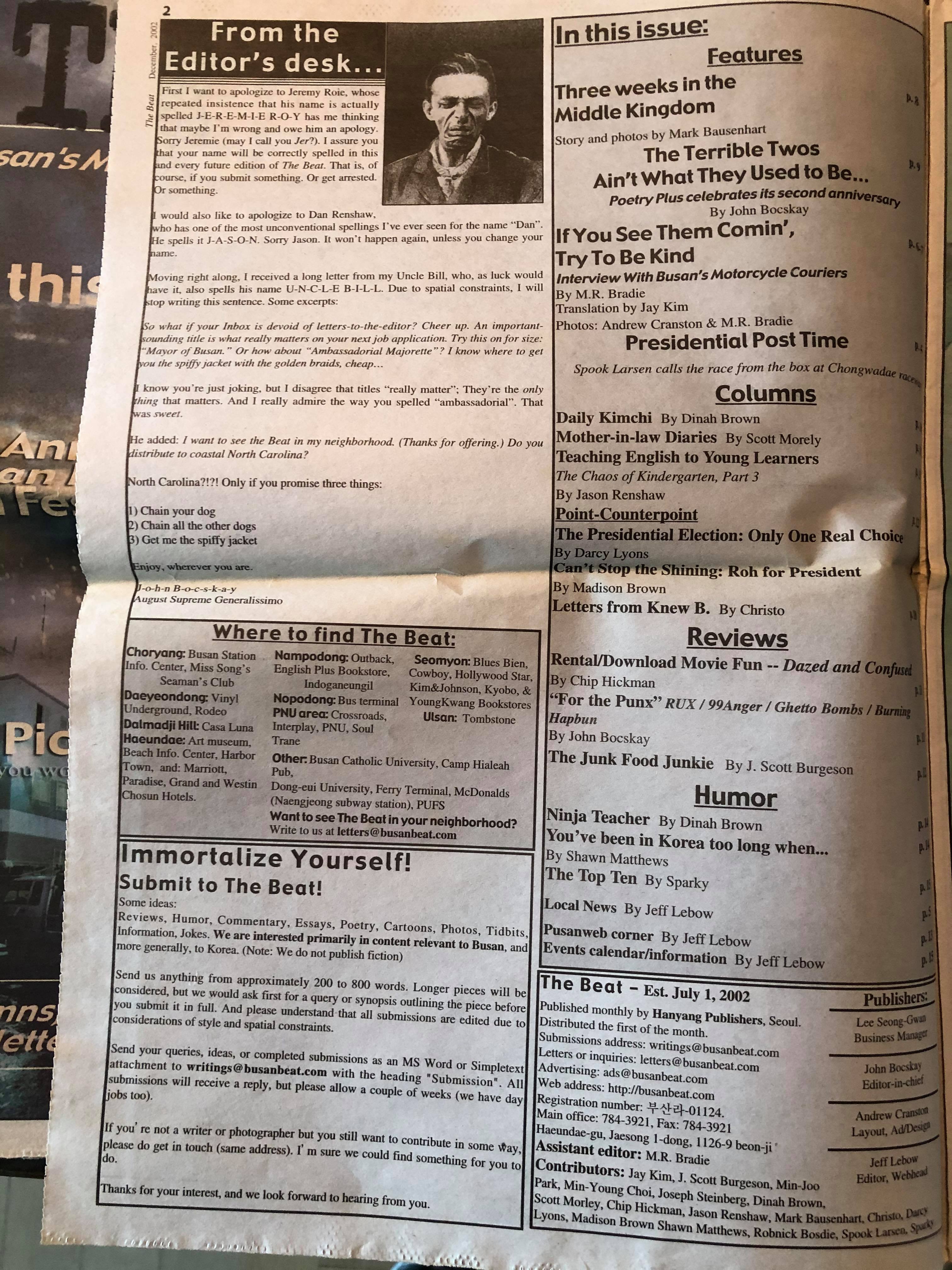
With no prior experience in printing, the quartet simply got it as they went along - helped in their endeavor by anyone who wished to submit articles, reviews, essays, photos, jokes, etc. They would usually gather at Andrew Cranston’s house for about three days per month in order to tirelessly prepare each issue. "The way we planned it, the newspaper was meant to beself-sustainable, mostly through the ads. Most of it was backscratching with bars and restaurants, but the result was worth it: on average, we printed and distributed around 3000 copies per month!" Having arrived in Korea four years earlier in Fall 1998, John Bocskay went so far as quitting his job as an English teacher and committed fully to The Beat. "Mostly as a way to get into writing proper."
인쇄물을 다뤄본 경험이 없었던 네 명은 단순한 방법으로 일을 진척시켰다. 원고, 논평, 에세이, 사진, 우스갯소리 등을 싣고 싶은 누구든 함께했다. 대개 한 달에 3일정도 앤드루 크랜스턴의 집에 모여 각 주제를 위해 지칠 줄 모르는 준비과정을 거쳤다. "우리는 신문이 자생할 수 있기를 바랐어요. 대부분 광고를 통해서였죠. 대부분의 광고는 바 또는 레스토랑 관련이었지만 결과를 보니 그럴만한 가치가 있었어요. 평균적으로 매달 3천 부를 인쇄하고 배포했습니다! " 1988년 가을부터 4년째 한국에 살고 있던 존 복스케이는 영어 교사직을 그만두고 온전히 더 비트에 심혈을 기울였다. "제대로 된 글을 쓰기 위한 노력이었죠."
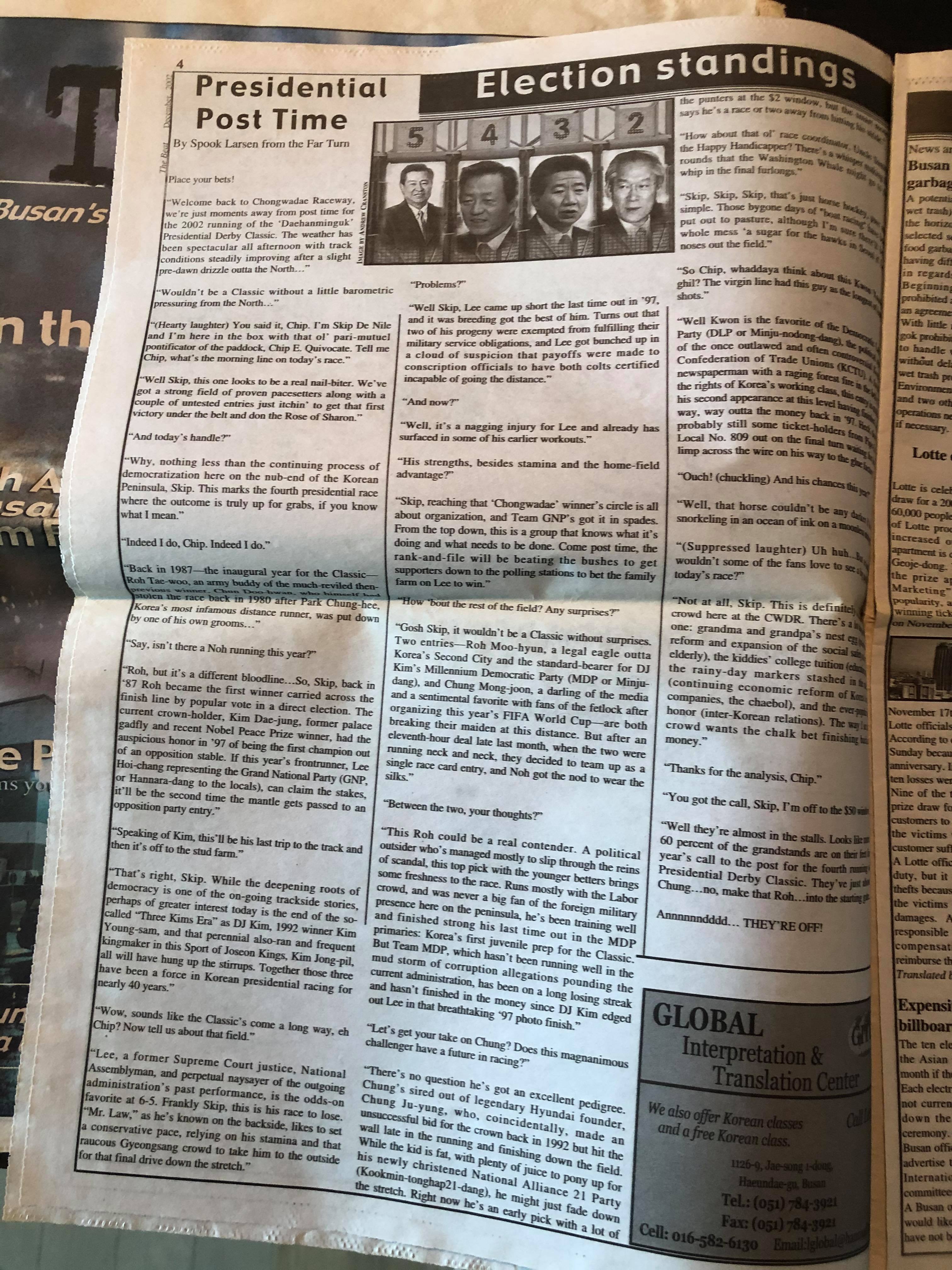
"The main idea was to have fun with it", he adds, "although we did care about our freedom in terms of tone, and in our choice of contents." That freedom visibly allowed them to treat subjects in a way that might be deemed too sensitive for a companyowned outlet, or even a public one. For instance: Presidential Post Race, an article written by Spook Larsen and published in issue 5, described the 2002 Korean Presidential election as if it were a horse race! Some headlines almost beg for reading, such as: The Great Guus Chase - in search of Hiddink-mania in the Netherlands (issue 13, August 2003); Night of Near Misses - Bachelor party at a Transgender Club (issue 22, May 2004); The Footwear of Political Change (issue 21, April 2004).
그는 이렇게 덧붙인다. "중요한 건 재미있게 하자는 거였어요. 어조나 컨텐츠 선택은 자유롭게 할 수 있도록 신경 썼지만요." 이 자유 덕분에 더 비트는 더 큰 규모의 회사나 공공기관에 속한 매체에서 다루기에는 너무 민감하다고 여겨질 수 있는 주제들을 다룰 수 있었다. 예를 들면 이런 주제들 말이다. 대통령 경선 경마. 스푹 라슨(Spook Larsen)이 5호 비트에 기고한 이 글은 2002년 대한민국 대통령 선거를 무려 경마에 비유한 글이었다! 읽어달라고 거의 간청하는 헤드라인도 있었다. 휘스를 좇아라- 네덜란드에서 히딩크 마니아 찾기(13호,2003년 8월). 유부남에 가까워지는 밤- 트랜스젠더 클럽에서의 총각 파티(22호, 2004년 5월). 정치적 변화가 신은 신발(21호, 2004년 4월).
Tongue-in-cheek humor and irreverence weren’t the only objectives, however. "We wanted to connect with culture and subculture in Korea. Staying off the beaten path, as it were." This direction is apparent in many of the articles, which were often bold and highly topical. The Beat’s choices for interviews, for instance, speak volumes on its founders’ street-level intentions, but also on their eclecticism: a motorcycle courier, a taxi driver, high school students, Russian hostesses, narrator models, a professional PC gamer, a mystery novelist, a Raelian bishop, a royal descendant of the Joseon Kings… "We even interviewed that well-known homeless man in Seomyeon, who would usually talk with foreigners in English."
Other examples are equally telling: Kadeokdo, Busan’sdisappearing paradise? (issue 12, July 2003), Busan during the Korean War (issue 14, Sept. 2003); Man Bites Dog, an inside look at a Busan dog market (issue 15, Oct. 2003); Who Killed Jamie Lynn Penich: three years later, are we closer to knowing the truth? (issue 14, March 2004)…
하지만 우스갯소리나 불경함이 그들의 목표였던 것은 아니다. "한국의 문화와 하위 문화를 연결하고 싶었어요. 늘 다니던 길에서 벗어난 거죠." 이 지향성은 대담하고 시사적인 여러 원고에서 분명하게 드러난다. 더 비트의 인터뷰는 창건자들의 의도와 동시에 그들의 절충주의적 면모도 그대로 보여준다. 오토바이를 타는 택배 기사, 택시 운전사, 고등학교 교사, 러시아인 진행자, 나레이터 모델, 프로게이머, 추리소설작가, 라엘파 주교, 조선 왕조의 후손… "외국인들과 영어로 토론하곤 하던서면의 유명한 노숙자를 인터뷰하기도 했어요."
다른 예도 마찬가지다. 가덕도. 부산의 낙원은 사라지는가? (12호, 2003년 7월). 한국 전쟁 당시의 부산 (14호, 2003년 9월). 인간이 개를 공격하는 곳, 부산개시장 (15호, 2003년 10월). 누가 제이미 린 페니크를 죽였나: 3년 후, 우리는 진실에 가까워졌는가 (14호, 2004년 3월)
Almost twenty years later, The Beat constitutes a fascinating window into the past.
Bocskay comments: "It provides a snapshot of a time and a place, of the life of a city. Not just the articles, but also the advertising: most of these restaurants and businesses who were our partners, sponsors or simply our distribution points are now gone." However, one then-nascent initiative which contributed regularly to The Beat has since become a mainstay of Busan’s cultural life: Poetry Plus, now better known as the Liquid Arts.
Why end the newspaper after two years, then?
"We burned out, and we realized it at the same time. It felt right to finish this project on our own accord, rather than letting it wither. Also, contrary to the creative part, the business part was struggling." John Bocskay went back into education, then in 2017 he took on the position of Director of International Affairs at the Office of the United Nations Memorial Cemetery in Korea. "We all grew from The Beat. Andrew Cranston developed his skills in layout and page design, and went into web design."
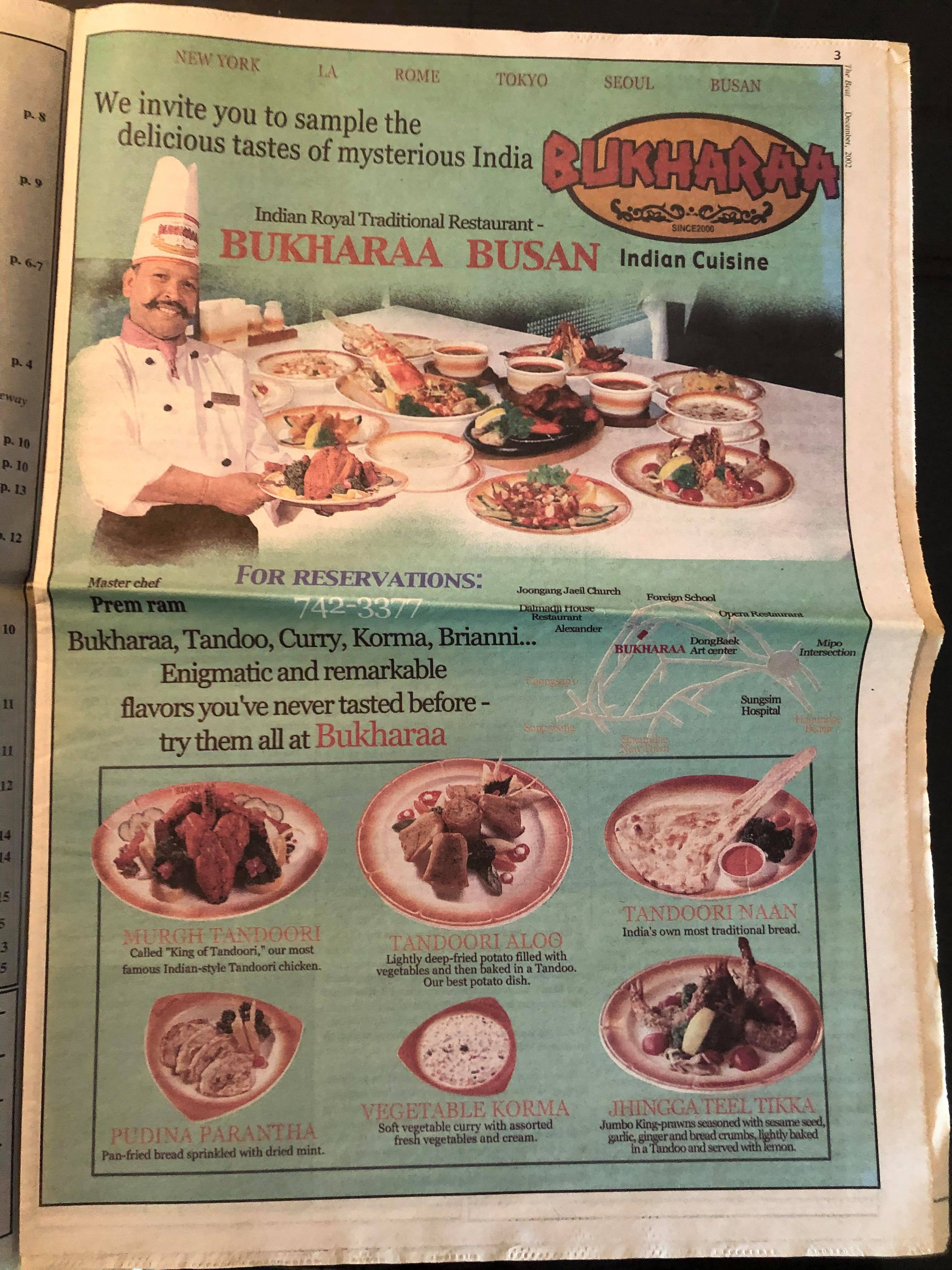
거의 20년이 지난 지금, 더 비트는 과거로 향하는 환상적인 창이 되었다.
복스케이는 이렇게 말한다. "이 도시의 시공간을 스냅샷으로 남겨둔 셈입니다. 원고뿐 아니라 광고도 마찬가지에요. 우리의 파트너이자 후원자,아니면 평범한 더 비트 배포지였던 대부분의 레스토랑과 사업장은 이제 사라졌습니다." 하지만 그 당시 더 비트가 추구했던 자주성은 현재까지도 부산 문화의 중심이 되어왔다. 포어트리 플러스. 지금은 리퀴드 아츠로 더 유명해진 이름으로 말이다.
2년 후에 신문을 폐간한 이유는 무엇인가요?
"우리는 너무 지쳤어요. 그걸 동시에 느꼈죠. 흐지부지하느니 자의로 이 프로젝트를 끝내는 게 맞다고 생각했어요. 창작 측면과는 달리 비즈니스 측면에서는 애를 먹고 있기도 했죠." 존 복스케이는 교육 현장으로 다시 돌아갔고, 2017년에는 재한 UN기념공원 국제부장이 된다. "우리 모두 더 비트 덕분에 성장했어요. 앤드루 크랜스턴은 레이아웃과 페이지 디자인을 깊이 공부해 웹 디자인계로 진출했습니다."
And what about the name of the newspaper?
"My uncle used to write for a magazine in North Carolina which had the same name."
The Beat ran for 24 continuous issues, from August 2002 until July 2004.
Thanks to John Bocskay and Kenneth May for their contributions to this article.
신문의 이름은 어떻게 되었나요?
"제 삼촌이 노스 캐롤라이나에서 동일한 이름의 잡지를 썼어요."
더 비트는 2002년 8월부터 2004년 7월에 이르기까지 24호를 발매했다.
이 글을 쓰는 데 협조해주신 존 복스케이와 케네스 메이에게 감사를 전합니다.
